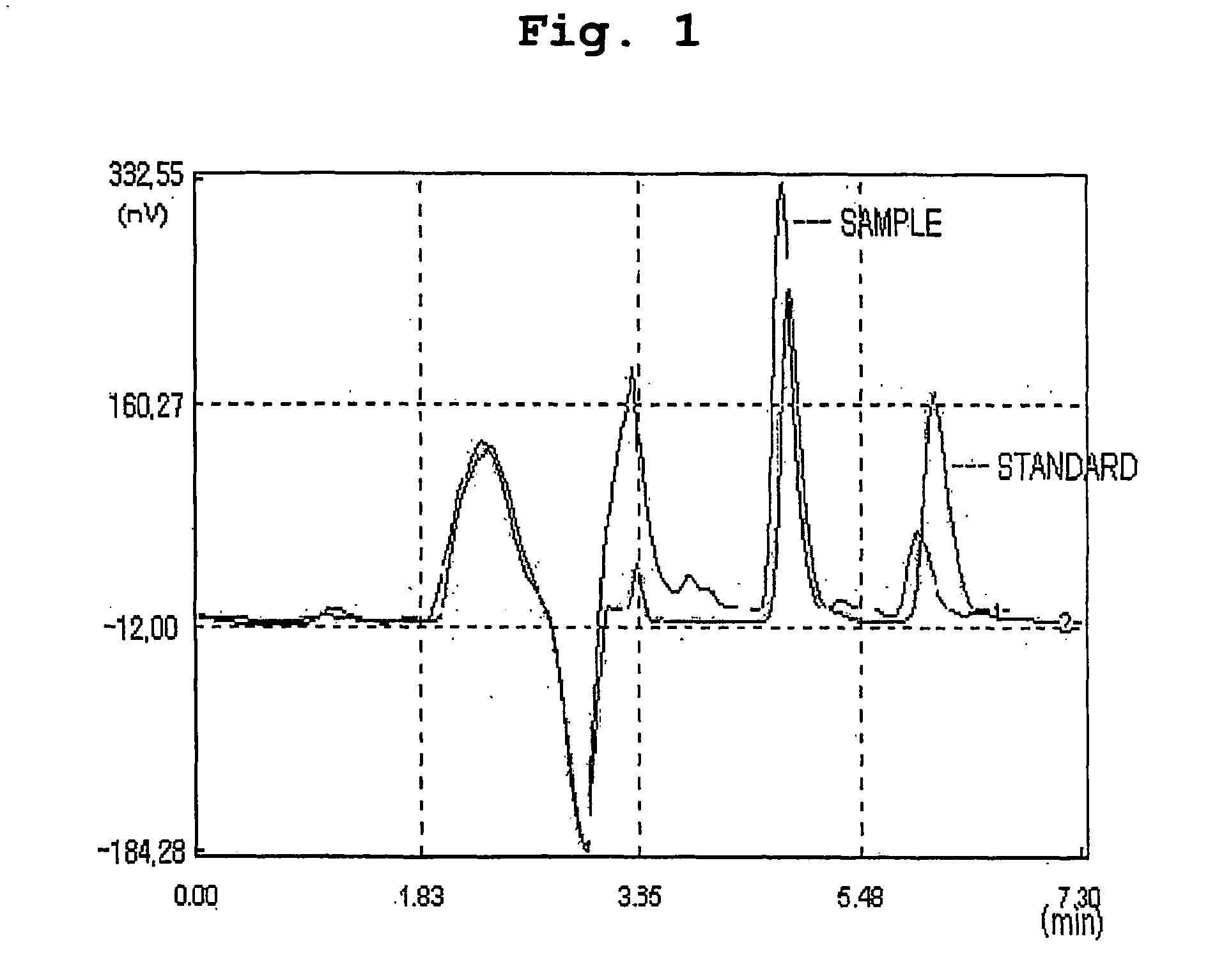Microorganism having ability to convert sterol into androst-4-ene-3,17-dione/androsta-1,4-diene-3,17-dione and preparation method and use thereof
a technology of androst-4-ene and androst-4-ene, which is applied in the field of microorganisms having, can solve the problems of low productivity of previously known microorganisms in synthesizing ad and adding
- Summary
- Abstract
- Description
- Claims
- Application Information
AI Technical Summary
Benefits of technology
Problems solved by technology
Method used
Image
Examples
example 1
Preparation of Mutant Strains
[0023] To induce mutation, Mycobacterium fortuitum strain (ATCC 29472) was inoculated in YNG medium, and cultured upon reaching O.D. 0.6 to 0.8, 5 ml of the cultured medium was centrifuged, obtaining a cell pellet. The obtained pellet was washed twice with sterilized 0.1 M sodium citrate buffer (pH 5.6) containing 0.5% Tween 80, and resuspended in 5 ml of the buffer, and NTG was added to the cell suspension at a concentration of 330 .mu.g / ml. NTG-treated cell suspension was incubated with shaking at 37.degree. C. for 90 min, and then centrifuged, obtaining a cell pellet and the obtained cell pellet was washed three times with a sterilized 0.1 M sodium phosphate buffer (pH 7.0) and resuspended in the buffer. The final cell suspension was loaded onto a SMI solid medium and incubated at 37.degree. C. for 3-4 days to form colonies.
example 2
Selection of Mutant Strains
[0024] Colonies obtained from Example 1 were inoculated in MS1, MS1+cholesterol, MS1+ADD (or AD) and YNG solid media and incubated at 30.degree. C. for 3 days to select a strain having both high growth rate in cholesterol-containing medium (MS1+cholesterol medium) and a low growth rate in ADD (or AD)-containing medium, and the selected strain was designated as Mycobacterium fortuitum EUG-119. The MS1 medium, a minimum inorganic medium, was used as a control, and compositions of the media are shown in Table 1.
1 TABLE 1 Culture medium (%) SM4 (Fermentation Ingredient YNG SM1 MS1 medium) Yeast extract 0.1 -- -- 0.5 Nutritional broth 0.8 -- -- --Glycerol 0.5 1 -- --Tween 80 0.1 -- -- 0.01 NaCl -- --0.0005 --K.sub.2HPO.sub.4 -- 0.05 0.02 0.04 KH.sub.2PO.sub.4 -- -- -- 0.08 NH.sub.4Cl -- 0.1 -- --MgSO.sub.47H.sub.2O -- 0.05 0.25 0.2 FeCl.sub.36H.sub.2O -- 0.005 -- --NH.sub.4NO.sub.3 -- -- 0.1 --FeSO.sub.47H.sub.2O ---- 0.0001 0.0005 Ammonium acetate -- -- -- 0.1...
example 3
Investigation for Conversion Rate of Cholesterol into AD and ADD in M. fortuitum EUG-119 Strain
[0025] Mutant strain, M. fortuitum EUG-119, selected from Example 2 was pre-cultured in 5 ml of YNG medium, and then cultivated at 30.degree. C. for 120 hours at 200 rpm in 100 ml SM4 fermentation medium (refer to Table 1) containing 1 g glucose, 0.5 g yeast extract, 0.01 g Tween 80 and various inorganic salts. Cholesterol was dissolved with acetone, because it is not dissolved well in culture media, and cholesterol suspension in acetone was added to the medium at an amount of 0.1 g cholesterol per 100 ml. After the incubation, cultured media were extracted with ethyl ether and petroleum ether and then dissolved with 2-propanol, and used in an analysis of amounts of AD and ADD produced by M. fortuitum EUG-119 strain from cholesterol, which was carried out by high pressure liquid chromatography (HPLC). A conversion rate of cholesterol into AD and ADD was represented as yield calculated by a...
PUM
| Property | Measurement | Unit |
|---|---|---|
| concentration | aaaaa | aaaaa |
| pH | aaaaa | aaaaa |
| pH | aaaaa | aaaaa |
Abstract
Description
Claims
Application Information
 Login to View More
Login to View More - R&D
- Intellectual Property
- Life Sciences
- Materials
- Tech Scout
- Unparalleled Data Quality
- Higher Quality Content
- 60% Fewer Hallucinations
Browse by: Latest US Patents, China's latest patents, Technical Efficacy Thesaurus, Application Domain, Technology Topic, Popular Technical Reports.
© 2025 PatSnap. All rights reserved.Legal|Privacy policy|Modern Slavery Act Transparency Statement|Sitemap|About US| Contact US: help@patsnap.com

